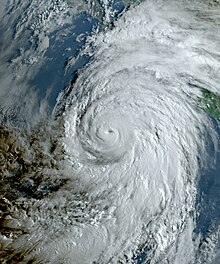 Hilary at Category 4 strength while paralleling the western coast of Mexico on August 18 | |
| Meteorological history | |
|---|---|
| Formed | August 16, 2023 |
| Remnant low | August 20, 2023 |
| Dissipated | August 21, 2023 |
| Category 4 major hurricane | |
| 1-minute sustained (SSHWS/NWS) | |
| Highest winds | 140 mph (220 km/h) |
| Lowest pressure | 940 mbar (hPa); 27.76 inHg |
| Overall effects | |
| Fatalities | 4 total |
| Damage | ≥$915 million (2023 USD) |
| Areas affected | Western Mexico, Revillagigedo Islands, Baja California peninsula, Western United States |
Part of the 2023 Pacific hurricane season | |
Hurricane Hilary was a large and powerful Pacific hurricane in August 2023 that brought torrential rainfall and gusty winds to the Pacific Coast of Mexico, the Baja California Peninsula, and the Southwestern United States, resulting in widespread flooding and mudslides. The cyclone was the eighth named storm, sixth hurricane, and fourth major hurricane of the 2023 Pacific hurricane season.[nb 1] Hilary originated from a tropical wave south of Mexico on August 16, and strengthened into a hurricane a day later while paralleling the southwest coast of Mexico. The hurricane underwent rapid intensification, reaching maximum sustained winds of 140 mph (220 km/h) and a central pressure of 940 mbar (27.76 inHg) on August 18, making it a Category 4 on the Saffir-Simpson scale. After environmental conditions became unfavorable, Hilary weakened as it approached land, making landfall on August 20 as a tropical storm in San Quintín along the western Baja California peninsula. Hilary became a post-tropical cyclone over land, before being absorbed into a new non-tropical low-pressure area early on August 21.
The threat from Hurricane Hilary prompted widespread and varied preparations. In Mexico, thousands of people evacuated to shelters as ports closed along the coast. In anticipation of "catastrophic and life-threatening flooding", the National Hurricane Center (NHC) issued its first-ever tropical storm warning for Southern California, extending from the Mexico–United States border to just north of Los Angeles. The Weather Prediction Center and various National Weather Service offices issued forecasts related to the rainfall potential, affecting about 26 million people across Arizona, California, Nevada, and Utah.
In Mexico, the hurricane killed three people and left at least 250 million pesos (US$14.7 million) in damage.[nb 2] Power outages affected 315,929 people in the country, although most service was restored within four days. The storm left behind flooded roads, mudslides and downed trees in the Baja California peninsula and in Southern California. Some areas of the latter region received up to 600% of their annual rainfall averages for the month of August. The floods killed one person in San Bernardino County, California. The estimated damage total in the United States was US$900 million, much of it in Inyo County, California, where most of the roads in Death Valley National Park were damaged by floods. The park was closed for two months, its longest ever closure. Hilary broke records in four U.S. states for wettest tropical cyclone or its remnants.
Cite error: There are <ref group=nb> tags on this page, but the references will not show without a {{reflist|group=nb}} template (see the help page).
© MMXXIII Rich X Search. We shall prevail. All rights reserved. Rich X Search
